If I were writing fiction about life in a war zone, I would not include a two-metre-tall black-clad German with a buzz-cut mini-Mohican, multiple tattoos and the deepest voice you ever heard, commanding a convoy of three blacked-out pickup trucks. Far too exaggerated and unrealistic!
However, reality doesn’t care about realism, so spent a month or so volunteering with Lars and his Universal Aid Ukraine colleagues, and living at their base in Kramatorsk, Donetsk region. Having already spoken to one of the neighbours, I got both Lars and UAU’s Ukrainian translator Vlada to go on the record about the foundation’s work. Over to Lars first…

How did you end up in Donetsk?
I'm actually an event technician. I do design and systems. It’s kind of the same as a war zone, the event industry. There are certain parallels there. Shit food, very long days of working, a lot of driving, and not a whole lot of sleep… But seriously, at the beginning of the war, I felt a kind of strong need to do something, though I didn't really know what. I don't have a medical background, I’m not a soldier, I don't have any experience in humanitarian work. But I can drive. I can drive for a long time. So I was like, hey, that's probably a good option. There were some people collecting all kinds of supplies, humanitarian aid, and they had five nine-seater vans, going down to the Romanian-Ukrainian border. So I asked them if they needed another driver, and they were like, hey, it just so happens that one of our people is no longer available.
So that's how I ended up going down to Suceava in Romania in March 2022. On the way back I was like, OK, that was good and all, but I think I can do more. So I took some unpaid time off in April and May. Stayed down in Romania, was working for those guys that I met there, and had some trips into Ukraine. It took me until summer to get out of my contract with my employer.
That’s when I fully moved over. I started to run supplies, mostly from Lviv to Kharkiv, but also Zaporizhzhia, Dnipro. I met Lea [Lars’ girlfriend, with whom he later founded UAU] in Kharkiv, after a couple of months of running back and forth in an off-road car. That took a lot of fuel, and was also not a very efficient way of doing things. But there were not many people doing that; supplies rarely ever went from west to east.
So I saw the need, and did that. Working mainly with Americans at that time. But they had to go back eventually, and I was sick of driving back and forth. So I stayed in Kharkiv and did more delivery runs there when it was still under siege. And it’s kind of been growing from there.

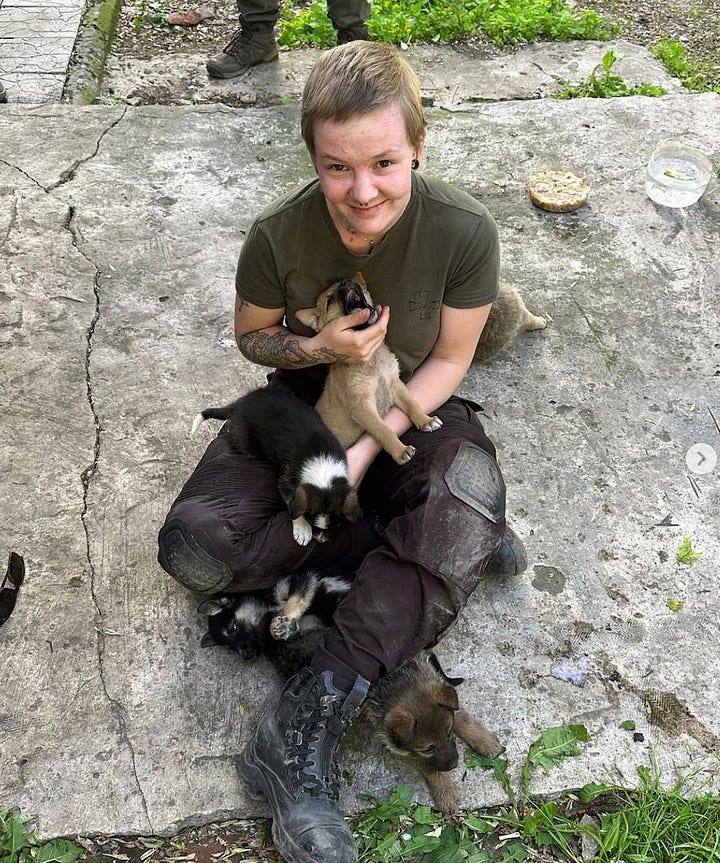
So what do you do on a daily basis?
The two things we do are deliver things to the stable frontline areas that are cut off from supplies, and getting people out of unstable areas. And nowadays there's a lot of organisational paperwork, since we got our own NGO, which was necessary but also annoying.
How does evacuation work?
There are multiple routes. In the Pokrovsk area, it was obvious that shit was going to get real and the area had to be evacuated, so we printed a thousand flyers saying, ‘Free evacuation! Call this number.’ And we put them up in every village that was in the path of the Russian advance. In every city, in all kinds of corners.
And the phone was just constantly ringing. People being like, ‘I want to get out. I've got a dog, I've got two suitcases’ or twenty or whatever it is. And then we’d go get them.
Or they don’t have reception at home any more, and family members know the situation is getting worse but they don’t have contact with grandma, grandpa, aunt, whatever it is. They call and say ‘Hey, can you go to this address, figure out if they’re there and take them out?’
That's the other option. Or it is coming from other people who do evac[uation]s in the same area but already have too much to do on their own. With the people we work with, it’s basically a sharing of requests, so things can be done more efficiently.
We never have too many people wanting to be evacuated. If it's a lot, then we find more people to go with us. Or we do multiple stages, but that usually doesn't happen. It’s not, like there’s a family of 200 people who want to leave. I think the max we got out was a family of eight. But that's fully possible with two cars.
There were 20 rabbits one time. That was a good one. But often it’s single people, generally younger ones, that call themselves. It’s rarely a babushka being like, ‘Yeah I think I’m going to go.’ And sometimes people need convincing, especially when family members are calling us to go there. We go there and they're like, ‘No, no, no, we don't want to go,’ and then you have to convince them to go, tell them how bad it is. If we're really tricky, we basically set up the Starlink, call their family members, put the phone in their hand and be like, ‘Yeah, figure that out between you two, we're coming back in an hour.’ And that works quite successfully, actually.
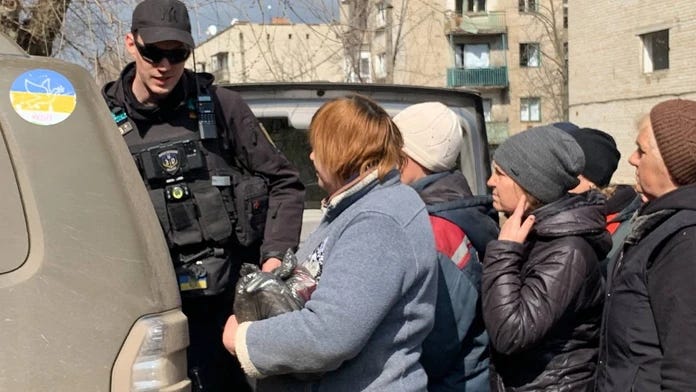
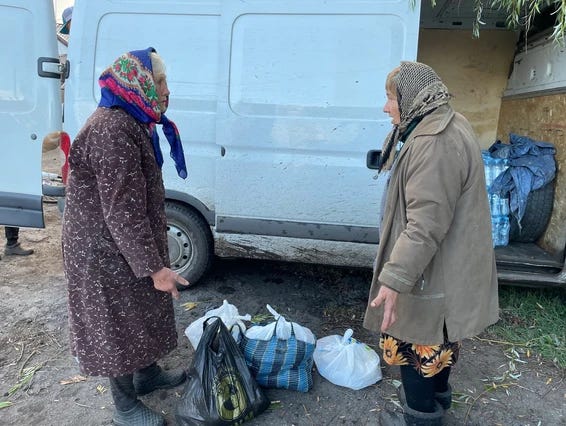
And where do they go after you've evacuated them?
That depends on what’s going on. Sometimes we bring them directly somewhere. Maybe they want to go to Kramatorsk if they know someone living there, or their family members are picking them up somewhere in the area. It doesn't happen too often. But most of the time it will be temporary shelters or evacuation points that are set up by the city or larger NGOs. In the Pokrovsk region there was an evac train going directly from the train station to Dnipro, I think once or twice a day. In the Toretsk area there was a bus system set up at the evac point.
There’s a lot of talk about the ethics of supply and evacuation…
We won't deliver aid to areas that are soon going to be Russian. And at the same time, we don’t evacuate people out of the areas where the frontline is stable, because they don’t see the need to leave, unless their house got blown up by random artillery or something.
There’s a lot of problems with evacuations. It’s already problematic for old people going somewhere else and the way the system works down the road… Think about your grandparents or parents. Once they reach a certain age and it's obvious that they can't really help themselves that much any more, taking them into a caretaking facility, it's quite a discussion. And that's if you’re in the same city and not hundreds of kilometres away.
And cities like Toretsk have been quiet since about 2016. People have been living a perfectly normal life even though the Russians were technically four or five kilometres down the road. But nothing happened in ’22, nothing happened in ’23, and then in ’24 they suddenly advanced and attacked the city again.
A lot of younger people decided it was time to make a smart move and get the fuck out of there. The ones who are left are problematic. Oftentimes they will just wait it out as long as possible. The front line is maybe 15 kilometres away, but they’re a small village and not massively affected. Yeah, they have artillery every now and then coming into the village. But it’s not too bad. So a lot of these people wait a very long time. In the meantime, they will need things. It doesn’t matter what you do, they’re not leaving, so you might as well help them to survive longer. Because otherwise, if they’re really actually cut off, then they won’t get anything.

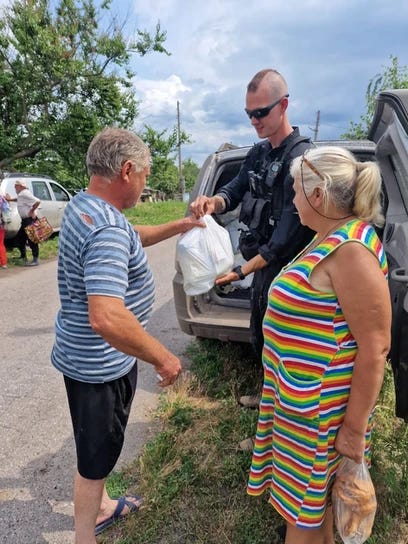
In Zarichne after liberation it was really bad. There were 120 people, give or take, and all of them had medical issues related to shitty food and shitty water. Because there was no power, no gas, no water coming into the village, so they were drinking puddle water, and that caused a lot of stomach issues. The entire city was basically in immediate need of medical help. And still they didn’t leave. Quite the opposite. There are about 600 people there now.
The last Russian advances were the fall of Soledar and Bakhmut. But the eastern part, with Bilohorivka, has basically not changed at all, since the fall of Lysychansk and Severodonetsk. So, those people are not leaving until that front collapses and then they’ll be moving towards the city of Siversk itself. Then maybe some of them will leave. But until then, there’s no point, you can’t convince them at all. You can try as much as you want to, but they will not leave. So you might as well make their life a little bit easier. It's not helping them to stay. Or it does not change their mind at all.
In fact, if we’ve been going there for two years and supplying them, they know us. And then the city becomes an actual frontline area, the Russians advance from the east towards Siversk… Maybe they might remember if they suddenly see a flyer with a number on it. They might think, ‘Hey, these dudes have been here for a while. Maybe it's an idea to call them.’
It's just a theory. I have no idea how much effect it actually has. But maybe it does help.
You must feel burnt out sometimes?
I wouldn't say burnt out, just tired. It's been a long time, it's a lot to do. I'm getting less efficient, I noticed that.
In most of ‘22 we were running missions every day of the week, sometimes multiple a day, and we did that into ’23 before we decided we need to slow this down. There was too much to organise in between. It’s just not possible to run two missions then work till three o'clock at night to organise and then get up at six because it's winter and you need to get the car started, which takes about another hour or two, then drive out and use the little daylight and repeat the whole process.
When there’s a big wave of evacuations, that takes a whole lot of energy and effort, like three weeks of going out multiple times per day in a row with no days off, which takes a big toll on us and also on the cars. So there’s a limit to how long we can do that. We’re not too unhappy about times in between when we have a slower pace, because we know that shit’s going to come again, I’m going to be hoping and praying for another day off.
Now, it’s mostly scheduled deliveries, two or three times a week. If there’s something bigger going on that requires evacs, that will be like, days and days on end, going out three, four, five times a week, depending on the situation. There were big waves of evacuations, two or three weeks in a row of going out every day multiple times, heading into Toretsk, Niu York, Vovchansk, the entire Pokrovsk area [when those areas fell or became frontline]. Which is exhausting.
But you don’t know ahead of time when that’s going to happen. At the moment, we’re expecting more evacs, and doing some things to prepare.
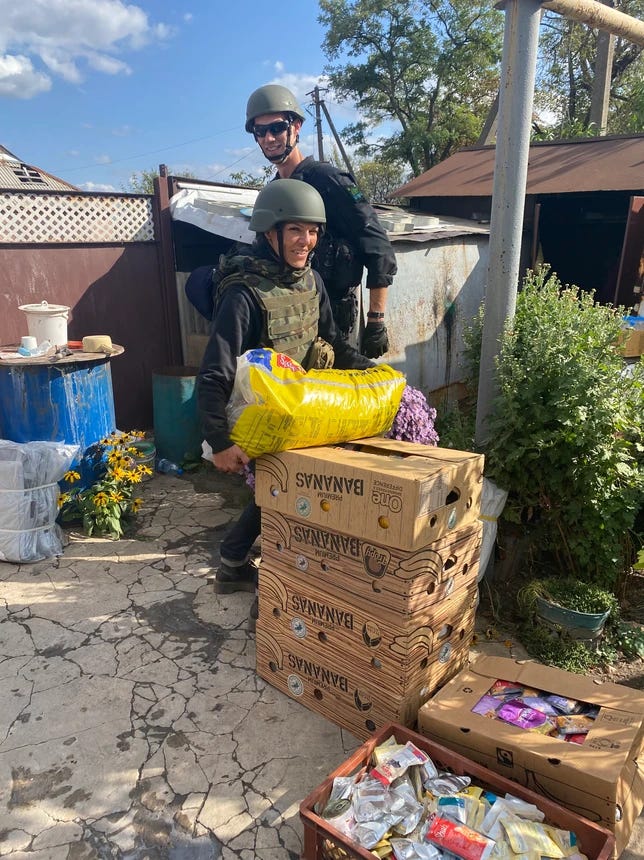
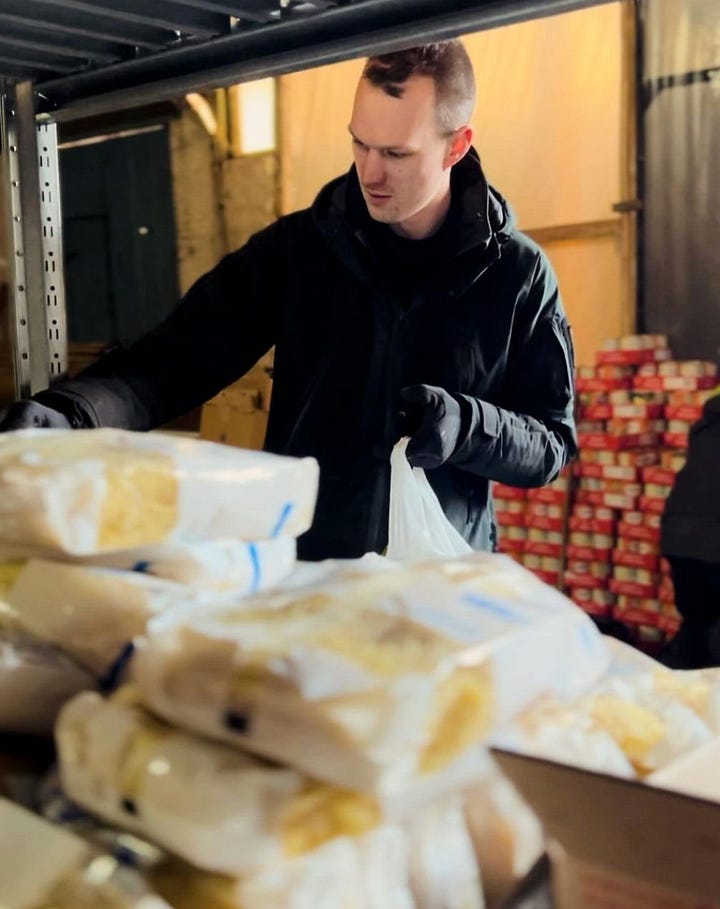
What are the biggest dangers?
You get used to the shelling around you, and certain dangers. Artillery is a constant danger. It doesn’t matter where you go, which front line, at any time, it’s always there. So that doesn’t really scare me, though the whistling of incoming artillery is never nice. But someone told me that if you hear the whistle, it’s not for you!
In the Kharkiv times [UAU operated there during and after the siege in 2022] it was actually mines after the liberation. You were going through a large area that has not been demined. Soldiers went through there, but you might be taking weird field roads because bridges are destroyed. We had friends that got blown up by mines because they wanted to take a shortcut, and they came back with one driver dead. So that was a scary thing at that time.
Obviously nowadays it’s the freaking FPV drones that are just a massive problem. Even back in the Bakhmut times [i.e. mid-2023], we could go as close as a kilometre from the Russian lines. There’s artillery and mortar, and technically at that point you’re within small arms range, but there are so many buildings in the way that it doesn’t really matter. Now, with FPVs, that corridor has been moved way further west. Villages two or three kilometres from the front would have been considered a normal mission. Now, you’d probably be dead by the time you were even close to the village because recon drones would have spotted you and FPVs been sent.
So, that is unfortunate! There’s, let’s say, respect for those things but not actual fear because that would just limit us. We need to be aware of the danger, and we need to take into consideration every area every time we go out and keep an eye open and do what we can to not get hit.

Kramatorsk is out of artillery range, for now. What is the situation here like?
I don't really want to [talk about] that, I'm going to just depress myself! Starting about two months ago, we had a lot more attacks on Kramatorsk with glide bombs, S-300s and cruise missiles. That happened a lot – cruise missiles, not glide bombs – at the end of ’22 and maybe January ’23, but most of the time since it was relatively quiet, every couple of weeks there was something flying into the city, but now it’s happening more often, which is not a good sign. And all around here, there's so many fronts that are not looking good, and we’re losing territory everywhere. The Russians’ ultimate goal will be to take Slovyansk and Kramatorsk, which are the two major cities in this area.
Do you anticipate leaving Kramatorsk?
We're making plans to fall back, because we have a lot of stuff here so we need to be prepared for that ahead of time, way ahead. Of course, if there's a major incident where a frontline actually collapses and we have to leave now or never, then obviously we'll just get as many important things in the car as we can and drive west.
But the rest depends on how badly things go. It’s down to how soon we need to go, because I think we will have to. Obviously there will be a battle for Kramatorsk, it might be a big one, but it will happen, and way before that we’ll be unable to work any more. We can’t get large amounts of supplies and store them in the warehouse and distribute them in areas that are further away when there’s too much incoming, too much drone observation, too much infrastructure shutting down. Like, we can’t work if there’s no gas stations around, or mechanics not working, shops closing. We need infrastructure to keep working and to keep our people and supplies, but mainly our people, safe.
So although it might be technically possible to stay here until the fighting is at the outskirts of Kramatorsk, it just does not make sense because we can’t have suppliers come in here. They’re way too valuable to put their lives at risk in a city that is constantly getting shelled by artillery. So at that point we need to go further away, or maybe have a small base here where we just stay for a couple of days to help around the area. But it remains to be seen…
What do you think about what Germany is doing to support Ukraine?
A lot of money has come from Germany to Ukraine, in terms of weapons or humanitarian aid, and Germany is one of the bigger countries that the EU money is coming from. But it’s not even remotely enough.
Like all those discussions about tanks. [In the opening months of the war, Germany dithered about whether to send tanks]. Come on, anyone could have told you that wouldn’t change anything, just send the fucking tanks. It’s easy to train tank crew compared to F-16s. It took forever, way too late to make a difference on the battlefield, and then there’s the freaking discussion about the Taurus [missiles].
The industrial capacities of Germany are huge. But not much is happening. Rheinmetall built some ammo factory somewhere, the process got slightly accelerated by the government but not much. And I know back then Rheinmetall said like, ‘Yeah, we're building the capabilities. The problem is we don't have the orders. There are no major orders for this kind of stuff!’
Thanks to Lars for his ongoing work. Donations can go through one of UAU’s partners in Germany, Lift Ukraine. Or to Lars’ fundraiser.
So, as you can tell from what Lars said, the situation is not great in Kramatorsk. By the time this post is published I’ll be on my way home to the UK, but as I first started working on it, I was listening to speculation about Russian advances going on down in the base kitchen. As part of this interview, Lars gave a lengthy account of the time the UAU convoy was hit by an FPV drone, which I’ve kept back for the next post, to be followed by an interview with translator Vlada.
Ultimately, if the Russians are coming, why bother? Well, Vlada will tell you because eastern Ukraine is her home, which is a pretty good reason. But Lars could theoretically pack his bags and retreat to Dnipro, or Germany… I could have not made contact with these guys at all…
Meet Granny Valya. Two weeks ago, Lars and Vlada got information from a soldier working in the area of Ivanopilya, a village to the south of Konstantinivka. They were nearby so they stopped at her house. It took a lot of talking back and forth but eventually she gave them her phone number and set up an evacuation. A few days later, Lars and Vlada returned to Granny Valya’s house. It took a while to get her out because she’s a little absent-minded, but they got her to a temporary shelter in Kramatorsk.
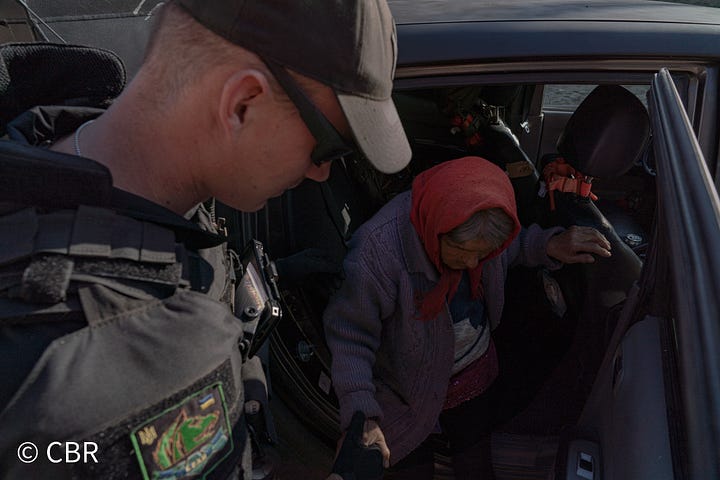
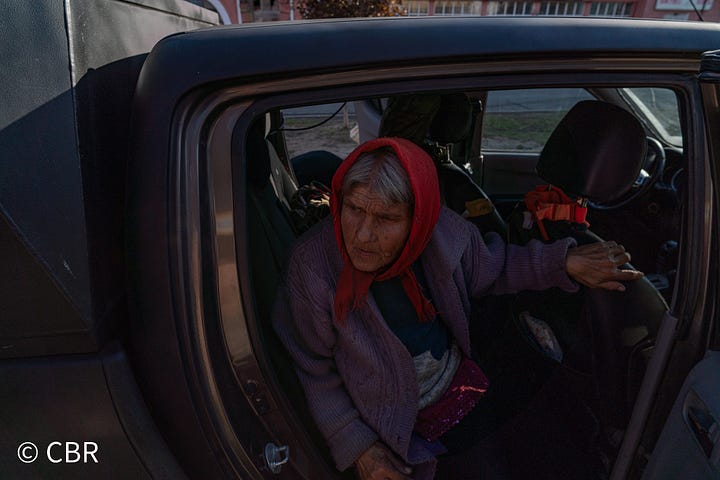
Then what? You might remember the Big Family shelter in Kharkiv. I contacted the administration and secured her a place. As of a few nights ago, she’s settling in nicely.





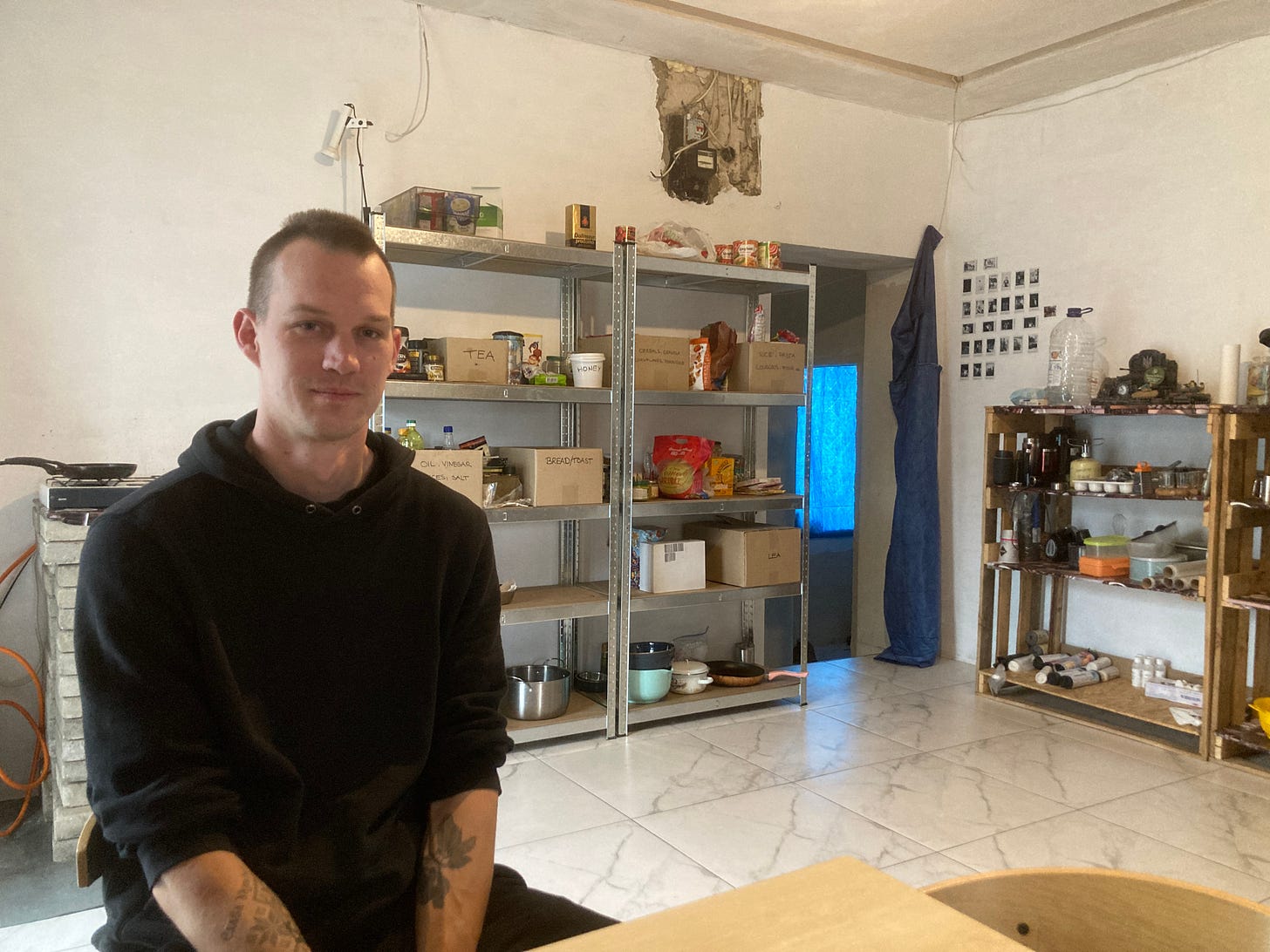


Amazing that they somehow find the energy to keep going month after month, when it’s so stressful just being in these areas and you have to be totally alert when you’re on the road - huge respect to them
Somehow it is comforting to know how much can be done in order to win a war and keep people (and rabbits...) safe, without even using weapons.Cheers for them!